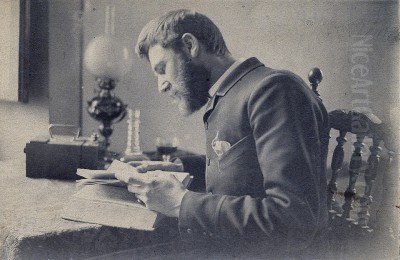
Robert Frederick Blum stands as a significant, if sometimes underappreciated, figure in the landscape of late 19th-century American art. An artist of remarkable versatility, Blum excelled as a painter in oils and pastels, a masterful etcher, a sought-after illustrator, and a distinguished muralist. His career, though tragically cut short, was marked by a keen sensitivity to his surroundings, a profound engagement with international artistic currents, and a pioneering spirit that helped introduce new aesthetic sensibilities, particularly Japonisme and Impressionism, to an American audience. His work is characterized by its luminous color, delicate draftsmanship, and an ability to capture the fleeting moments of life with grace and vibrancy.
Early Life and Artistic Formation in Cincinnati
Born on July 9, 1857, in Cincinnati, Ohio, Robert Frederick Blum was the son of German immigrants. Cincinnati at this time was a burgeoning cultural center in the American Midwest, boasting a significant German population that fostered a rich artistic and intellectual environment. From a young age, Blum displayed a precocious talent for drawing. His formal artistic training began in his early teens when he was apprenticed to the Gibson & Co. lithography firm. This practical experience in a commercial art setting likely honed his skills in draftsmanship and composition, providing a solid foundation for his later endeavors.
While working as a lithographer, Blum pursued his passion for fine art by attending evening classes at the McMicken School of Design (later the Art Academy of Cincinnati). A pivotal moment in his early development came in 1874 when he began studying under Frank Duveneck, a charismatic Cincinnati-born artist who had recently returned from Munich. Duveneck, with his bravura brushwork and dark, rich palette influenced by the Munich School and masters like Wilhelm Leibl, had a profound impact on a generation of young Cincinnati artists, who became known as the "Duveneck Boys." Blum was among this circle, absorbing Duveneck's emphasis on direct observation and vigorous technique.
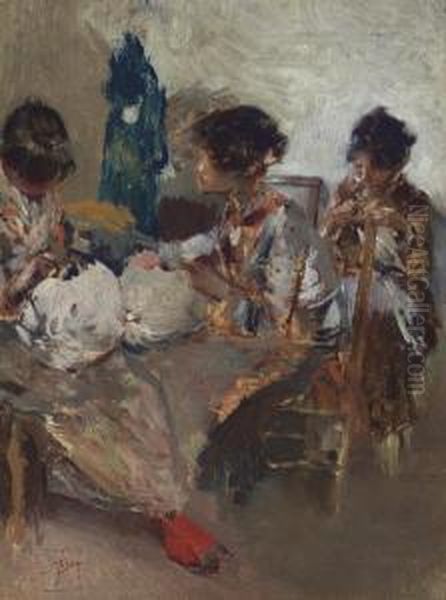
Furthering his education, Blum also spent time at the Pennsylvania Academy of the Fine Arts in Philadelphia, one of the premier art institutions in the United States. There, he would have been exposed to the teachings of artists like Thomas Eakins, known for his uncompromising realism, though Blum's own path would diverge towards a lighter, more decorative style.
New York, Illustration, and European Horizons
In 1879, seeking broader opportunities, Robert Blum moved to New York City, which was rapidly becoming the epicenter of the American art world. He quickly established himself as a talented illustrator, a field that offered steady employment and a wide audience. He began working for Scribner's Monthly (which later became Century Magazine), one of the leading illustrated periodicals of the era. His illustrations were noted for their elegance and technical skill, often depicting scenes of contemporary life and travel. This work as an illustrator not only provided financial support but also sharpened his narrative abilities and his eye for detail, qualities that would inform his paintings.
Blum's ambition, however, extended beyond illustration. He was eager to immerse himself in the artistic developments of Europe. His first significant trip abroad took him to Venice in 1880. This city, with its shimmering light, picturesque canals, and rich artistic heritage, captivated him. It was in Venice that he encountered James McNeill Whistler, the expatriate American artist whose aesthetic theories and distinctive style were making waves on both sides of the Atlantic. Whistler's emphasis on "art for art's sake," his subtle tonal harmonies, and his interest in Japanese art resonated deeply with Blum. The encounter spurred Blum's interest in etching and, particularly, in pastels, a medium Whistler championed.
During his European travels, Blum also fell under the spell of the Spanish-Italian painter Mariano Fortuny y Marsal. Fortuny's dazzlingly detailed genre scenes, characterized by their brilliant color, sparkling light effects, and meticulous rendering of textures, were immensely popular. Blum admired Fortuny's technical virtuosity and his ability to create vibrant, almost jewel-like surfaces. This influence can be seen in Blum's own work, particularly in his lively depictions of Venetian life and his later Japanese subjects. Other contemporary European artists whose work likely informed his developing style include Giovanni Boldini, with his fluid brushwork and elegant portrayals of society figures.
The Allure of Japan: A Pivotal Journey
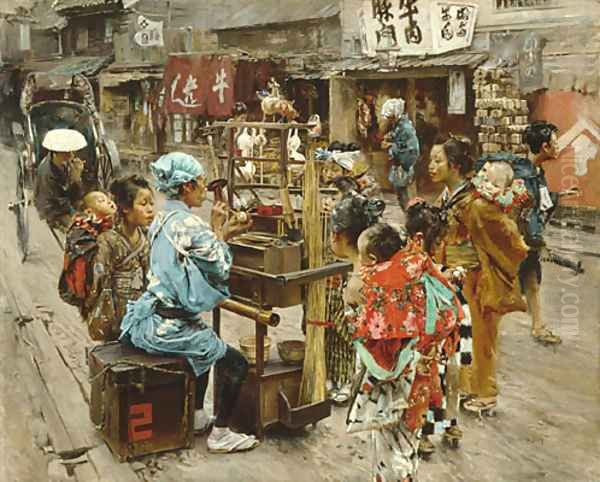
One of the most defining experiences of Robert Blum's career was his journey to Japan. In 1890, he was commissioned by Scribner's Magazine to travel to Japan with the English writer Sir Edwin Arnold to create illustrations for Arnold's book Japonica. Blum ended up staying in Japan for nearly three years, from 1890 to 1892, a period of intense creative activity and profound cultural immersion.
At this time, Japonisme – the influence of Japanese art, culture, and aesthetics on Western art – was a powerful force. Artists like Whistler, Edgar Degas, Mary Cassatt, and Vincent van Gogh had already incorporated elements of Japanese Ukiyo-e woodblock prints into their work, drawn to their asymmetrical compositions, flat planes of color, and decorative patterns. Blum was one of the first American artists to experience Japanese culture firsthand for an extended period and to translate that experience so directly into his art.
He was enchanted by the landscapes, the people, and the customs of Japan. He produced a remarkable body of work during his stay, including oil paintings, watercolors, pastels, and countless sketches. His Japanese subjects ranged from bustling street scenes and vibrant festivals to intimate portrayals of geishas and artisans. He was particularly adept at capturing the delicate beauty of Japanese women in traditional attire, the play of light on silk kimonos, and the graceful gestures of everyday life.
His time in Japan also saw him serve as a judge at Japan's Third National Industrial Exhibition in Tokyo in 1890, an indication of the respect he garnered even within the Japanese art community. The illustrations he created for Japonica, and the subsequent paintings and pastels based on his Japanese experiences, played a crucial role in popularizing Japanese imagery and aesthetics in America. Alfred Parsons, another noted illustrator, also contributed to Japonica, and their collective work helped shape Western perceptions of Japan.
Mastery of Mediums: Oil, Pastel, and Etching
Robert Blum was a versatile artist, comfortable and proficient across several mediums, each chosen to best suit his expressive needs and subject matter.
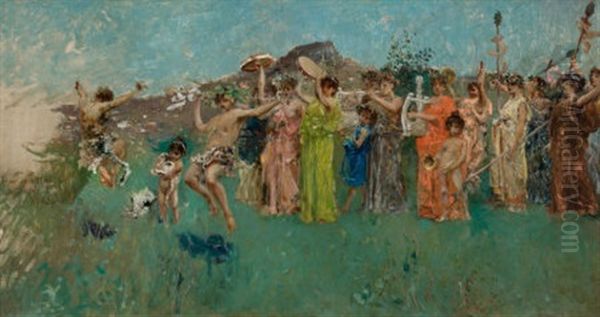
His oil paintings often display a bright, high-keyed palette and a concern for capturing the effects of light, aligning him with the Impressionist movement. Works like Venetian Lace Makers (1886) showcase his skill in rendering intricate details and lively human interaction within a sun-drenched Venetian setting. This particular painting earned him a bronze medal at the Paris Exposition Universelle of 1889, a significant international recognition. Another important oil, The Ameya (also known as The Candy Vendor, 1892), painted after his return from Japan, depicts a Japanese street entertainer surrounded by children. It is celebrated for its vibrant color, animated composition, and sympathetic portrayal of Japanese life. The painting was widely acclaimed and further solidified his reputation.
Blum was a particularly gifted pastellist. He was drawn to the medium's immediacy, its ability to combine drawing and color, and its luminous, velvety texture. Influenced by Whistler's advocacy for pastels, Blum became one of its foremost practitioners in America. He co-founded the Society of Painters in Pastel in New York in 1882, alongside artists like William Merritt Chase. Chase, a leading American Impressionist and influential teacher, shared Blum's enthusiasm for the medium. The society played a vital role in promoting pastel as a serious artistic medium, distinct from its preparatory or amateur connotations. Blum's pastels, such as The Blue Obi (or Girl in a Blue Obi), are exquisite examples of his delicate touch, refined color sense, and ability to capture subtle nuances of expression and atmosphere. These works often feature Japanese subjects, where the soft, blendable nature of pastel was perfectly suited to rendering the textures of kimonos and the gentle features of his models.
Etching was another area where Blum excelled. His Venetian etchings, created during the early 1880s, demonstrate a Whistlerian sensitivity to line and tone, capturing the picturesque decay and atmospheric charm of the city. An example like Roman Man with Donkey (1880) shows his early command of the medium, with confident lines and an understanding of light and shadow. His involvement with the New York Etching Club further underscores his commitment to the graphic arts.
Mural Commissions: Art on a Grand Scale
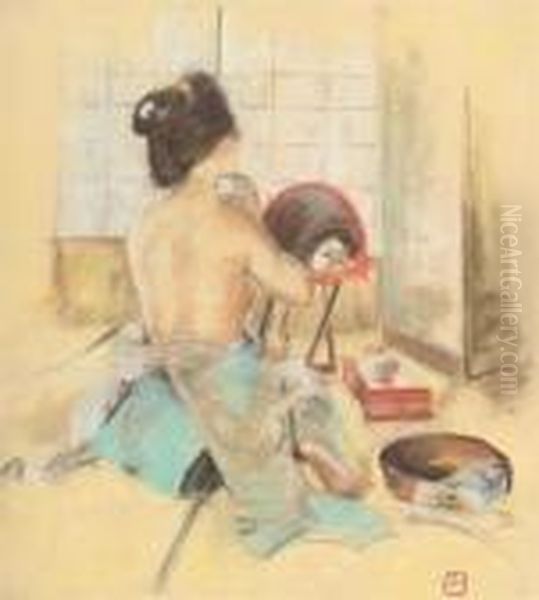
Later in his career, Blum turned his talents to mural painting, a field that was experiencing a renaissance in America as part of the "American Renaissance" movement, which saw a surge in public art and grand architectural projects. His most significant mural commission was for the Mendelssohn Glee Club Hall in New York City. He created two large friezes, Moods to Music (or Music and the Dance) and The Vintage Festival, completed around 1895. These allegorical and decorative works, filled with graceful figures in flowing draperies, showcased his skills in composition on a large scale and his ability to create harmonious and elegant designs. Moods to Music was particularly well-received and earned him a gold medal at the Pan-American Exposition in Buffalo in 1901. These murals are now housed in the Brooklyn Museum, preserving an important aspect of his oeuvre. He also executed murals for the New Amsterdam Theatre in New York. These mural projects placed him in the company of other prominent American muralists of the period, such as John La Farge, Edwin Austin Abbey (a close friend and fellow illustrator), and Kenyon Cox.
Artistic Style: Impressionism, Japonisme, and a Personal Vision
Robert Blum's artistic style is a fascinating synthesis of various influences, primarily American and French Impressionism, and Japonisme, all filtered through his distinct personal sensibility. He was not a strict adherent to any single dogma but rather selectively incorporated elements that resonated with his artistic aims.
His connection to Impressionism is evident in his bright palette, his interest in capturing the fleeting effects of light and atmosphere, and his often informal, slice-of-life compositions. Like many American Impressionists, such as Childe Hassam or John Henry Twachtman (another of the "Duveneck Boys"), Blum adapted Impressionist techniques to American subjects and his own temperament, often retaining a greater degree of solidity in form than his French counterparts like Claude Monet or Pierre-Auguste Renoir.
Japonisme was perhaps the most defining influence on Blum's mature work. His extended stay in Japan allowed for a deeper engagement with Japanese aesthetics than was common among his contemporaries. He absorbed not just the compositional devices of Ukiyo-e prints – the asymmetrical arrangements, high vantage points, and decorative patterning – but also a genuine appreciation for Japanese culture and its artistic traditions. This is evident in the sensitivity and authenticity of his Japanese scenes.
Beyond these broad stylistic categories, Blum's work is characterized by its elegance, refinement, and a certain decorative charm. He possessed a superb sense of design and a delicate touch, whether in the intricate lines of an etching, the subtle gradations of a pastel, or the vibrant brushstrokes of an oil painting. His figures are often graceful and imbued with a quiet dignity. There is a pervasive sense of beauty and harmony in his art, a celebration of the visual delights of the world.
Associations and Professional Life
Throughout his career, Robert Blum was an active participant in the art world, maintaining connections with many leading artists of his day. His early association with Frank Duveneck and the "Duveneck Boys" provided a supportive and stimulating environment. His friendship and artistic dialogue with James McNeill Whistler were crucial in shaping his interest in pastels and etching, and in fostering an aesthetic sensibility that valued subtlety and refinement.
His collaboration with William Merritt Chase in founding the Society of Painters in Pastel highlights his role as an organizer and advocate for specific artistic practices. He was also a member of the National Academy of Design, being elected an Associate (ANA) in 1882 and a full Academician (NA) in 1892, making him one of its younger members to achieve this distinction. He was also a member of the Society of American Artists, an organization formed by younger, more progressive artists, and the American Watercolor Society. These affiliations indicate his standing within the professional art community.
His work as an illustrator brought him into contact with writers like Sir Edwin Arnold and fellow illustrators such as Edwin Austin Abbey and Charles Stanley Reinhart. These professional relationships often extended into personal friendships, creating a network of creative exchange.
Recognition, Legacy, and Untimely Death
Robert Blum achieved considerable recognition during his lifetime. His works were exhibited widely in the United States and Europe, and he received several prestigious awards, including the aforementioned medals from the Paris Exposition and the Pan-American Exposition. His paintings and pastels were sought after by collectors, and his illustrations reached a broad public.
Tragically, Robert Frederick Blum died relatively young, on June 8, 1903, in New York City, at the age of 45, from pneumonia. His early death cut short a career that was still evolving and promised further achievements.
Despite his contemporary success, Blum's reputation somewhat faded in the decades following his death, as new artistic movements like Modernism came to the fore. However, in recent years, there has been a renewed appreciation for his work, particularly for his contributions to American Impressionism, his pioneering role in introducing Japonisme to American art, and his mastery of the pastel medium.
His works are held in the collections of major American museums, including the Metropolitan Museum of Art in New York, the Brooklyn Museum, the Cincinnati Art Museum, the Smithsonian American Art Museum, and the Museum of Fine Arts, Boston. These collections preserve his legacy and allow contemporary audiences to experience the beauty and skill of his art.
Robert Frederick Blum's enduring legacy lies in his ability to synthesize diverse artistic influences into a coherent and personal vision. He was a bridge between cultures – American, European, and Japanese – and between mediums. His art, characterized by its luminosity, elegance, and keen observation, offers a captivating window into the artistic currents of the late 19th century and stands as a testament to a dedicated and remarkably gifted artist. His exploration of light and color, his embrace of new aesthetic ideas, and his technical finesse secure his place as an important figure in the history of American art. He remains an artist whose delicate yet vibrant works continue to charm and impress.